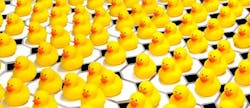X-ray laser harnesses crystal imperfections to allow for better biomolecule study
The most difficult step in taking atomic-resolution images of biomolecules is getting them to form the high-quality crystals needed for x-ray studies of their structure. So, researchers at the Department of Energy’s SLAC National Accelerator Laboratory (Menlo Park, CA) and collaborators have shown they can get sharp images even with imperfect crystals using their lab's x-ray laser source. Their results could in many cases make the search for better crystals obsolete and fundamentally change the way scientists study the complex biological machinery involved in photosynthesis, catalysis, and many other important processes in living things. What's more, it could drive innovation in a number of areas, including drug development.
Related: $25 million grant will help support x-ray laser imaging of biomolecules
X-ray crystallography, which uses x-rays to probe the interior of crystals, is one of the most important techniques for analyzing the structures of materials, chemical processes, and biomolecules. For instance, the method has been hugely successful in determining the atomic structures of proteins and shining light on protein function. To date, well over 100,000 protein structures have been determined with the method, which requires many copies of a protein to be incorporated into a single crystal.
When x-rays pass through the crystal, they scatter off the protein molecules and form a pattern on a detector. This diffraction pattern is dominated by bright spots known as Bragg peaks, and researchers use these spots to reconstruct the atomic structure of the molecules.
A perfectly ordered crystal would produce nothing but Bragg peaks. However, disorder limits the number of detectable peaks and, therefore, the resolution of the molecular image that can be obtained from the peaks alone. Disorder also produces gently rippling patterns between and beyond the sharp Bragg peaks. While these patterns, known as “continuous diffraction,” have been actively studied, they had not been considered capable of producing high-resolution molecular images. But the SLAC research team has demonstrated that they can actually use the continuous diffraction of imperfect crystals to obtain better molecular images than with Bragg peaks alone, according to Kartik Ayyer, the study's lead author from the Center for Free-Electron Laser Science (CFEL) at the German research center DESY.
The researchers applied their method to crystals of photosystem II—a large protein machine involved in photosynthesis—and found that combining information from Bragg and non-Bragg signals produced higher-resolution images with significantly more structural detail than images obtained with the conventional Bragg-only method. The study shows that the continuous diffraction of the photosystem II crystals stems from molecules in the crystal lattice that have shifted out of their ideal positions by as little as the width of a single atom. X-rays scattering off these displaced molecules combine to form the observed continuous pattern rather than Bragg peaks.
One clear benefit of the technique is that it allows researchers, in principle, to reconstruct a biomolecule’s atomic structure from scratch, without knowing the locations of some of its atoms or the structure of a similar protein beforehand as a starting point. This would eliminate a major bottleneck and be a stepping stone toward molecular imaging of single particles.
The approach holds the promise to dramatically change the way scientists exploit x-ray lasers for biological studies, and its wider application is currently being assessed. It remains to be seen whether the technique can also be used at synchrotron facilities--x-ray light sources that are less powerful, but much more widespread than x-ray lasers.
Although the researchers have demonstrated their method only on photosystem II, they are confident that it will work for other biomolecules as well.
Full details of the work appear in the journal Nature; for more information, please visit http://dx.doi.org/10.1038/nature16949.
Follow us on Twitter, 'like' us on Facebook, connect with us on Google+, and join our group on LinkedIn


